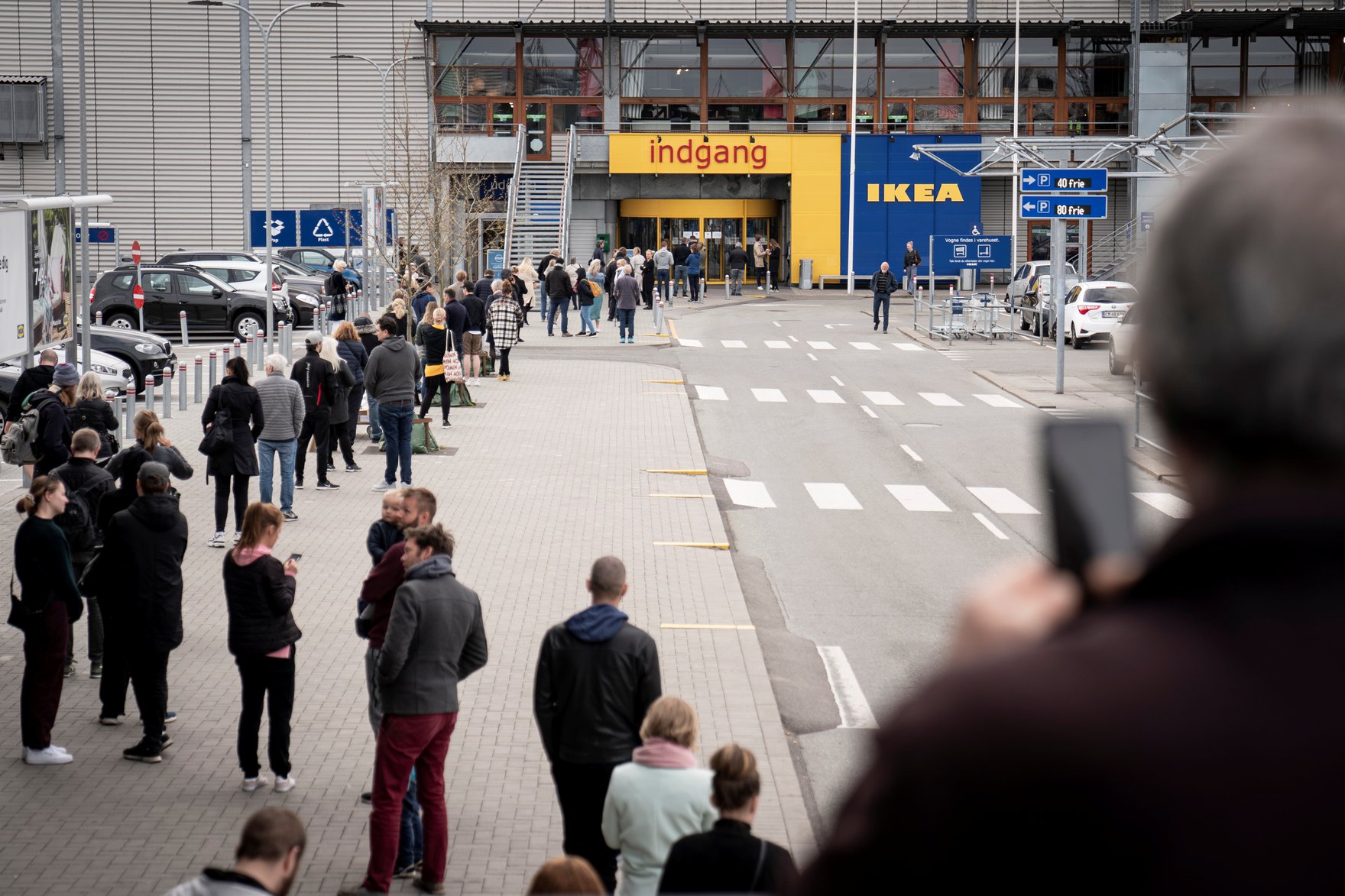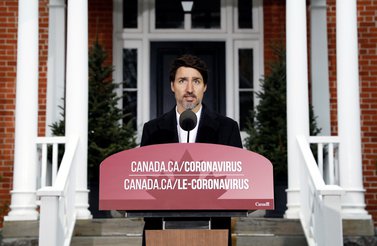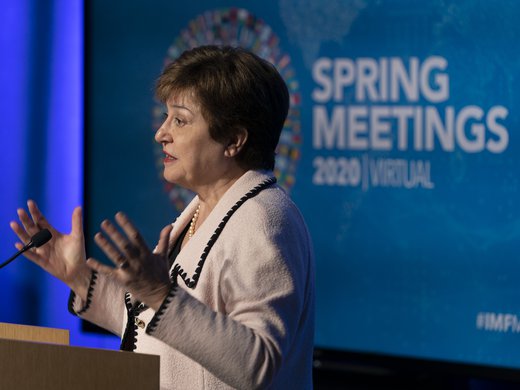Data is real. The model is hypothesis.
—Dr. Anthony Fauci
The policy measures taken to address the COVID-19 pandemic have plunged the global economy into the greatest recession since the 1930s. These measures were motivated by the experience in regions where the virus was initially uncontained and resulted in overwhelmed medical systems and exponentially growing mortality figures. However, from the very early days of the pandemic, model simulations — based on epidemiological theory and the available evidence — played a role in informing governments about various options for policy intervention, including no intervention at all.
Now, governments around the world are pivoting to consider when, how and under what conditions they will ease the lockdowns and reboot their economies, driven by the need to limit the atrophy of production webs and supply chains, and the pressure from increasingly restive populations. Model simulations of disease spread and control can play an important role at this stage as well: first, by informing the construction of the package of public safety protocols needed to ensure that the economic reboot does not entail medical relapse; and second, by helping to instil public confidence in the re-opening strategy — which will be critical to invigorate the economic rebound — while underscoring the need for compliance with the safety protocols.
With the COVID-19 outbreak, we are all becoming familiar with the SIR (susceptible-infectious-removed) models or the slightly more elaborate SEIR (susceptible-exposed-infectious-removed) models. Such models describe the population’s transitions through various states, from being susceptible to infection (that is, having no antibodies to guard against the virus), to encountering the virus, to becoming infected, to being “removed” from the at-risk population by virtue of either having recovered from the infection or by death.
Governments around the world are pivoting to consider when, how and under what conditions they will ease the lockdowns and reboot their economies.
A critical parameter in these models is the basic reproduction number (R0) — meaning the number of people in a completely susceptible population who will be infected by one contagious person. If this parameter is below one (R0 < 1), any introduction of the virus into a community — for example, through international travel — will tend to die out. Identifying the operating conditions under which R0 < 1 would allow economies to reopen on a controlled-risk basis.
A second key parameter that informs policy is the confirmed case fatality rate (cCFR). It is now reasonably well established that the cCFR rises steeply for individuals who are older and who have underlying health conditions that predispose them to more serious outcomes. People in front-line jobs are also at greater risk, given their greater opportunity for exposure. Tailoring the reopening protocols to preserve strict protection for this portion of the population would permit the economy to reboot in a socially responsible way.
As Dr. Anthony Fauci, director of the National Institute of Allergy and Infectious Diseases, stated, data is real and models are only hypotheses; however, as we discuss below, models provide a way to leverage the available data on COVID-19 in several ways. First, modelling can inform policy on the least economically costly set of measures required to keep the pandemic from breaking out of control. Second, in light of China’s experience in reopening Wuhan, which suggests that populations will be hesitant to re-engage (returning to work, going shopping and so forth), simulations can provide governments the communications material they need to accelerate re-engagement. Third, and by extension, modelling data can reinforce the credibility of the public messages regarding the need for compliance with the reboot protocols.
Modelling the Pandemic: The Role of Quantitative Scenarios
Considering the well-established use of model simulations in areas such as fiscal, monetary and trade policy, the importance of simulations in guiding policy choices in the COVID-19 pandemic may have been unprecedented, as a special report by David Adam in Nature on the role of Imperial College London’s pandemic modelling scenarios suggests: “When updated data in the Imperial team’s model indicated that the United Kingdom’s health service would soon be overwhelmed with severe cases of COVID-19, and might face more than 500,000 deaths if the government took no action, Prime Minister Boris Johnson almost immediately announced stringent new restrictions on people’s movements. The same model suggested that, with no action, the United States might face 2.2 million deaths; it was shared with the White House and new guidance on social distancing quickly followed.”
Underscoring the role of quantitative projections — in particular, the sensitivity of decisions to specific assumptions — the “updated data” Adam refers to was prompted by a change in an assumption in the modelling data: a change that doubled the percentage of hospitalized cases that would require intensive care from 15 percent to 30 percent.
The value of models in shining a light on possible futures is set in sharp relief by the case of New Zealand. As of March 14, 2020, New Zealand had only six confirmed COVID-19 infections and no deaths. Yet, the government saw simulation figures (in its subsequently published strategy document) predicting that 89 percent of the population would be infected in the absence of measures, and that, in the context of an overwhelmed health system, 80,000 would die. Armed with these figures, Prime Minister Jacinda Ardern stated: “I will not take that chance…We’re going hard and we’re going early.” On March 14, New Zealanders were given two days to prepare for what was, in effect, house arrest for the majority of the population.
The value of models in communications, meanwhile, is underscored by the example of Germany’s Chancellor Angela Merkel explaining the scientific basis for her government’s lockdown policy and the steps being taken to reopen the economy under controlled conditions. Such communications will not likely be just an afterthought in the current circumstances: societies face a very real “paradox of prudence,” whereby individual consumers, faced with heightened uncertainty about the future, reduce or eliminate discretionary spending and thus collectively bring about a much weaker recovery — and, in fact, heighten the very risk of job loss or reduced income that they are seeking to hedge against.
In Canada, modelling of the pandemic in the first instance had a much lower profile than in the country examples mentioned above. Canada appears to have followed international practice in formulating its response to the pandemic, intensifying its measures over time as the totals of new confirmed cases, hospitalizations and deaths mounted, undoubtedly drawing on internal modelling, but without publishing. This changed, starting in late March, when British Columbia released the results of scenarios showing the implications of no policy intervention versus policy interventions; in short order, Ontario, Alberta, Quebec and then the federal government followed suit. Of particular importance, the modelling scenarios provided confidence that public health authorities were planning ahead to ensure that the health system would not be overwhelmed. While this is an important contribution — and provides the basis for an informed debate — formal modelling could prove to be of even greater utility in the next phase of managing the pandemic: establishing the conditions for the economic reboot.
Basic Insights from Epidemiological Models
Models, by their nature, are highly simplified descriptions of a process. They are typically guided by theory and often constrained by data availability. The model builder starts with a basic set of statistics, provides a structure that describes the process, introduces estimates of the parameters that describe the dynamics, and generates outputs that are the statistics of interest for users. The model builder then “calibrates” the model to reproduce historical data or trends.
In Figure 1 (which is an uncalibrated, generic graph generated by a SIR model), the susceptible population — s(t) — falls from 100 percent to about 40 percent. The “removed” population — r(t) — which has been infected and either survived or died, rises to about 60 percent. The infected population — i(t) — first expands exponentially as the disease propagates through the population, then slows down as fewer and fewer susceptible individuals remain; eventually, the percentage of new infections declines and dies out, resulting in a new post-epidemic equilibrium state.
Figure 1: SIR Model for Spread of Disease
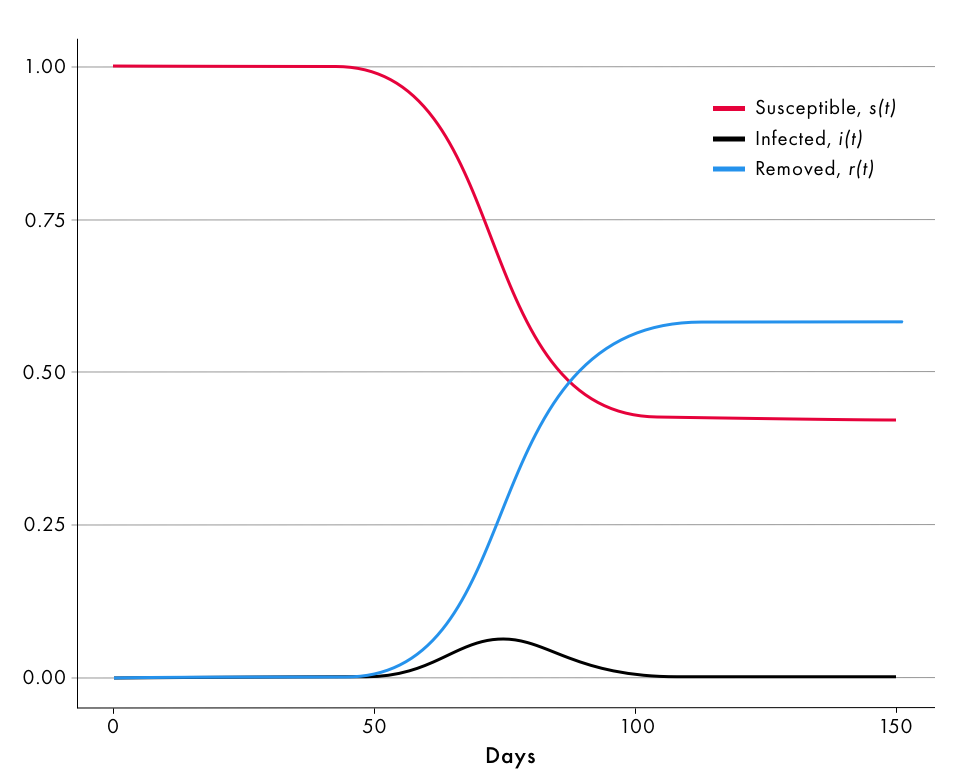
Even a very simple quantitative framework such as in Figure 1 allows important inferences to be drawn to prepare and guide policy.
First, given that some percentage of the currently infected population requires intensive care, the more rapid the expansion of the infected share of the population, the more difficult it will be to provide beds and proper treatment in intensive care units. A well-calibrated model allows policy makers to examine several possible futures, energizes the adoption of countermeasures to slow the pace of transmission (that is, to “flatten the curve” or “crush the curve”) and informs the preparation of resources to cope with the flow of patients.
Second, until a suitable drug treatment or vaccine is developed, the countermeasures must be retained long enough to eliminate the virus and strictly control any subsequent cycle of incipient breakout. Models help illustrate this point, as they show that the full relaxation of controls in a context where the virus could still be introduced would allow it to resume its spread through the as-yet non-immune portion of the population, resulting in a second (and possibly third) wave of infections. Modelling these waves reinforces the lessons from history as it explains the experience with the Spanish Flu outbreak of 1918. For example, a simple model generates a policy response routine that engineer Tomas Pueyo calls “the hammer and the dance,” a metaphor for a world in which policy is relaxed, and then tightened again from time to time, to keep the disease in check if it re-emerges.
Third, in a multi-country setting, where different countries are at different stages in this process, international contact can reintroduce the virus, which will still find a susceptible host population. Currently, economies such as China, Taiwan, Hong Kong, Singapore and Vietnam that successfully limited the spread of the virus in the first wave through rapid and effective countermeasures have, as a direct corollary, maintained relatively large shares of their population in the susceptible category. Not surprisingly, some are seeing an uptick in their infection rates as time goes on, most likely due to international contacts, and thus are forced to introduce new measures or reintroduce old ones. Models buttress the policy message that countries must prepare for this risk. The multi-country example is also applicable to a country such as Canada that has distinct regions at different phases of the transmission cycle.
Using Models to Inform and Communicate Coping Strategies
Beyond the basics, model simulations can help in designing coping strategies for the period after community transmission has been controlled enough to permit the rebooting of the economy but before a vaccine or effective treatment options are available. For example, New Zealand, in its modelling, set out the assumptions concerning the extent of reduction of transmission by the various measures it was imposing (see Figure 2).
Figure 2: New Zealand’s Assessment of Alternative Transmission Reduction Strategies
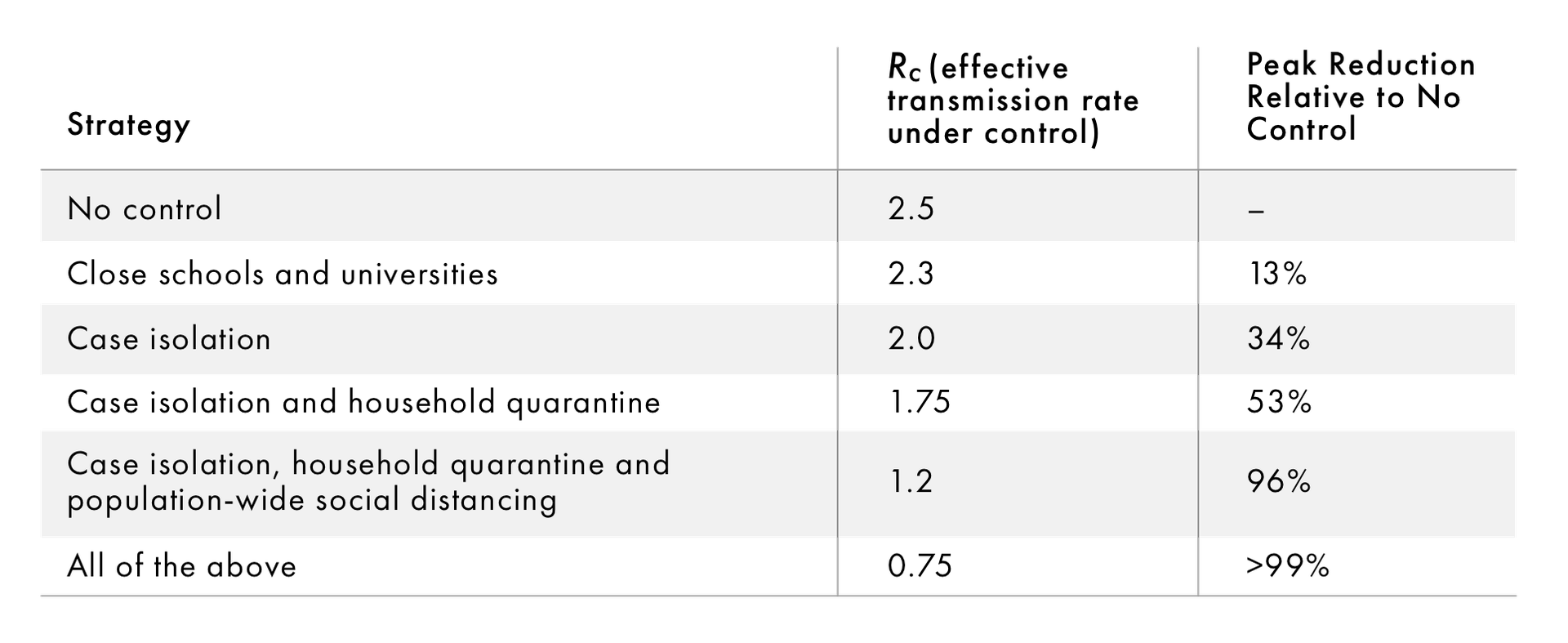
Such a parsing out of the effects of different measures is highly promising as a way to inform the construction of policy frameworks to reboot economies. In particular, modelling the pandemic with the population disaggregated by age, sex, occupation and region can help structure more finely articulated and targeted control protocols and their interactions. In fact, the reopening will not simply be the reverse of measures put in place. Modelling can be used to inform how to sequence the reboot in different sectors of the economy that have different risk characteristics. And it can be used to inform workers and businesses about the support that they would receive in various scenarios of being kept away from work, or conversely, returning to work.
This leads to a highly policy-relevant question: by how much would the basic reproduction number be reduced in any given socio-economic setting by taking special measures for particular groups, and how could this information guide the rebooting of the economy?
First, let’s consider the high-risk groups of workers. Front-line workers are particularly at risk of catching the virus and serving as vectors of transmission. Besides health-care workers, this group includes workers in the tourism, retail and hospitality sectors, as well as those working in transport, security and construction. These job categories were identified by researcher David Koh early on as at risk.
To illustrate the importance of addressing this question quantitatively, a scenario could model a set of interventions for high-risk individuals. Assume that this set of interventions is subject to the Pareto Principle — that is, that 20 percent of these measures would yield 80 percent of the effective reduction in transmission. In this case, the 20 percent of the most effective measures would eliminate 80 percent of the high-risk spreading opportunities. In simple math terms, these measures would reduce a 2.5 R0 to 0.9, which is below the threshold for self-sustaining transmission.
Second, let’s then consider low-risk individuals. Qualitative assessments suggest that masks represent an imperfect safeguard against infection and transmission. In a quantitative evaluation, however, the relevant question would be by what percentage a mask would reduce the risk of infection and transmission. To give a quantitative example, suppose that a person wearing a makeshift mask reduces the risk of infection and transmission by only 20 percent. If all the people encountered in public spaces are also wearing similarly imperfect masks, the risk of becoming infected or transmitting in any given encounter would be reduced by an amount equal to 0.8 multiplied by 0.8, that is, 0.64 percent, multiplied by the underlying risk of infection in any encounter.
Layered on the measures to reduce infection and transmission of the high-risk individuals, the societal basic reproductive number would be further reduced from 0.9 to perhaps about 0.6.
Third, some sectors likely need additional protocols, given that some workplaces have served as “super spreaders.” The Smithfield pork packing plant in South Dakota is an example. A scenario could model a mandatory risk-reduction plan, perhaps developed by industry associations in conjunction with public health protocols to ensure it is relevant to the operating conditions in these firms. Similarly, for schools, a set of mandatory protocols could be required (for example, a fever test, similar to that used at airports, prior to entering the school, or another perhaps more appropriate technique given the circumstances) to shave off some further percentage of the risk of transmission. New York Mayor Bill De Blasio announced the formation of advisory groups for precisely this kind of function. The cumulation of the effects of measures taken in each sector could then be fed into the modelling framework to determine whether the measures put the overall economy on track for a controlled-risk re-opening.
Fourth, since older people are more vulnerable to serious illness and death than younger people, taking some additional measures for those 65 years of age and older would further slice the risks for the most vulnerable population to below that for the general population.
The above calculations are purely hypothetical put forward for the sake of argument. The key point that quantitative modelling shows is that we do not need perfection — we only need to keep R0 < 1. Identifying the minimum set of imperfect measures that cumulatively reduce the basic reproductive number well below one (taking into full account the level of confidence we have about the initial estimate of the basic reproductive number) enables an economic reboot on a safe and socially responsible basis.
Even with an R0 < 1 for a region as a whole, localized outbreaks are nonetheless likely to reoccur. It will be important to support the reboot protocol with randomized testing to identify new clusters, which can then be targeted with tracing and isolation to stamp out the incipient outbreaks. Taking account of the Pareto Principle in designing responses does not obviate the need for test and trace — it underscores its importance.
Governance Considerations
Numbers that emerge from models in the kinds of scenarios described here can give a false sense of precision. There are confidence bounds around the key parameters that drive the model results and considerable uncertainty about the estimates of the risk-reduction potential of particular measures. Moreover, one particular issue is that the parameters typically reflect historical experience. In a pandemic, behaviour is likely to change — indeed, public interventions are designed to change behaviour — and the parameters may no longer be relevant and lead to scenarios that are misleading. This likelihood is an important consideration in the interpretation of scenarios and needs to be kept in mind as scenarios for rebooting are developed. It will require different types of sensitivity analysis on key model parameters that reflect assumptions on how behaviour may have changed. In the current context, these technical questions inform life and death decisions and so need to be spelled out.
From a governance perspective, the goal in calibrating the information that is published is to balance what is necessary to understand the scenario against the insatiable demand for more detail. More generally, transparency comes with its costs: scenarios will be used in different ways by different groups for different purposes, which can create confusion. Some ideas on a way forward include:
- Make data and the models publicly available for replicability. This sharing of information is typically done in scientific journals and is valuable since scenarios could be used to make life or death decisions.
- Create a public repository for the data and models used by the provinces and the federal government. This repository would be the “trusted,” publicly accessible source for members of the media and citizens alike.
- For any of the scenarios, make clear the assumptions that are being used. Doing so allows others to explore the sensitivity of the results to the assumptions and to generate other scenarios. It is important, too, that the question being addressed in a scenario be made clear, so as to avoid confusion on interpretation. In particular, it will be very important to be clear on the impact of various interventions in a staged recovery.
- Create a repository of key studies and models that are being used nationally and internationally so that we can learn from what other countries are doing. Because the virus has affected different regions at different times, and because different regions have implemented different interventions at different times, we can learn from this variation and use it to tease out the implications of various strategies. Here is where modelling is extremely useful; it allows a tractable way to take into account various factors and trace their impact.
- Finally, there is understandably an eagerness to bring in new data and technologies to help in tracking and tracing, but these require the development of adequate governance controls, as Sean McDonald, among others, has written.
Conclusion
Voltaire famously said that we should not let the perfect be the enemy of the good. In the case of the coronavirus response, we believe that quantitative modelling of potential responses can enable policy makers in finding (if not a perfect path) a responsive and responsible course of action.
We acknowledge that models and simulations are only part of the input influencing decisions. Ultimately, the ministers sitting around a table weighing a wide range of information — anecdotal as well as analytical — will make these fateful decisions. Policy makers have rarely had to rely on expert analysis to the extent they must during this pandemic. Presenting that expert analysis in quantitative terms, relating measures to specific parameters that drive decisions and sharing how analysis informs decision making are, in our view, extraordinarily valuable contributions. Ultimately, communicating fully and with clarity to the public will build confidence that the situation is under control, and that confidence will underpin the recovery.
